|
In Part I, we
discussed the methods used by Rick Kelter of the Los Angeles silhouette club to
produce a perfect cast bullet. Rick has shot a ton of 40s, 60s, and even 80ís
with his bullets, so we know the steps he takes result in a very high quality
product. Duplicate those efforts and anyone can have the same result. To quickly review: use good metal like wheel weights with 2% tin
added, use a proven bullet design (in this case the RCBS 200 grain .358" rifle
bullet), make sure the bullet is sized perfectly concentric with a Star straight
thru sizer, make sure the gas check
doesnít shave any metal off the bullet shank and that itís fixed perfectly flat
on the base of the bullet. Heat treat your bullets so theyíre strong but not
brittle, and use a quality lube, size bullets before heat treating so they donít become work softened
during the process. If you didnít have a chance to read Part I and want to know
the details on how to achieve these results, go to
(Part One) for the whole story.
Now itís time to pay attention to case selection and preparation. In
explaining his use of IMI cases (available at Widenerís), Rick stated that
several years ago, Ken Light did an evaluation of various brands of 357 cases
and found that IMI was the most consistent. Therefore Rick decided to go with
IMI as well. Being curious, I decided to examine the IMI cases that Rick
provided for the evaluation and to do a similar examination on the Starline
cases that I normally use.
The usual method that most people use when evaluating revolver brass
is to weigh them. This is supposed to be an indicator of how consistent the
internal volume of the case may be. (Heavier cases will have thicker walls and
therefore wonít be able to hold as much powder as cases with thinner walls,
which will also weigh less.) Ideally then, weíd like cases that all had the same
internal volume, since variations in volume/weight in a given group would
translate into pressure variations, and that then would translate into velocity
variations.
Consequently, I weighed 25 randomly selected cases from each brand. I
then calculated the mean weight and the standard deviation of weight for each.
(Talk about tedious - ugh). The IMI brass had an mean weight of 73.95 grains and
a standard deviation of .593 grains. I found this to be impressive - until I did
the calculations for the the Starline brass - average weight 72.6 grains and a
standard deviation of only .266 grains. Very impressive. The Starline
brass was 1.35 grains less in weight, so should hold just a tiny bit more
powder.
|
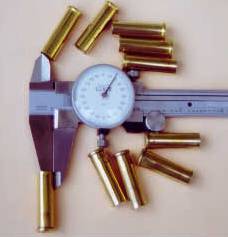 |
|
"Measuring case wall
thickness is a useful
method to judge case quality." |
|
However, an even better way to evaluate brass quality is to measure
the uniformity of the thickness of the case wall at the mouth. Ideally, weíd
like brass that has exactly the same thickness all the way around.
Unfortunately, normal production variances prevent that from happening. The
result is that when the bullet is seated, itís not perfectly centered in the
case mouth, but rather is pushed off to the side by the thicker wall toward the
thin side of the case. The end result is that the bullet isnít perfectly aligned
with the bore when the gun is fired even if everything else is absolutely lined
up.
To overcome this situation, itís fairly common for people interested
in precision shooting to neck turn their bottle necked cases to uniform
dimensions all the way around. However, pistol brass gets no respect from most
of the manufacturers of reloading tools (Redding excepted) and often does not
even get respect from the shooting community itself. The consequence of this is
the fact that there are no neck turning tools available that can uniform
revolver brass. This is probably the result of years and years of pistol brass
being used in revolvers where the manufacturing tolerances were - shall we say -
"generous". So it really didnít matter if the brass wasnít uniform, because the
gun it was being shot in was as loose as a goose. However, things are changing,
and when it comes to the Freedom Arms revolvers, itís a whole different world
out there. The precision of the FA is equal in every way to a hand crafted
benchrest rifle. Consequently, it can make a difference if bullets are
seated off center because of poor case wall tolerances.
I then measured the case walls of the same 25 cases from each brand
and found that the case wall variance from one side to the other for IMI brass
was only a maximum of a .001 of an inch. Additionally, 80% of the IMI cases had
exactly the same variance in their wall dimensions. This means that the case
walls were indeed, very consistent.
For Starline, the maximum case wall variance was .002 of an inch. 62%
of those cases had the same variances. Not as consistent as IMI, but still
pretty good. Frankly, I wouldnít have any problem using either brand. As an
aside, Sinclair International, who sells a lot of neck turning tools, says if
case wall variation is .003 of an inch or less, neck turning is probably not
needed.
Now trimming. This is a very important operation for pistol brass. In
many brands of brass , case length can vary significantly. The result is that
when a bullet is seated in the case and crimped, the variable length of the
cases will determine the amount, or "hardness" of the crimp being applied.
Additionally, it will also determine where in the bulletís cannelure the crimp
takes place (low, middle, high, or maybe even out of the cannelure). The amount
of crimp and placement of the crimp, in turn, can affect the consistency of the
powderís ignition, and cause velocity changes from shot to shot. Bottom line -
we want all the cases to be the same length to avoid these variations.
In this particular situation, we also have another reason for
trimming our cases. If youíre familiar with the RCBS 200 grain bullet, you know
that it has a long nose. If the bullet is seated so that case is crimped into
the crimping groove, the overall length of the bullet will be too long and the
nose will protrude outside of the mouth of the Freedom Armís cylinder. That in
turn will prevent the cylinder from being rotated. Solution? We have to shorten
the case length slightly. The standard length for a 357 case is 1.29". Rick had
his cases shortened to l.278" which was just enough to keep the nose of the
bullet inside the cylinder (barely). Rick likes to keep the bullet as far out in
the chamber as possible to insure that the entire front driving band is inside
the throat. The theory is that the bullet will be held in alignment as it starts
to move and mean less opportunity for misalignment on
the way from the cylinder to the barrel. This is a good procedure for most
revolvers. However, the barrel/cylinder alignment on the
Freedom Arms is very
precise. However, youíll note that some of my loads
below involved crimping over the front driving band with no apparent loss of
accuracy.
|
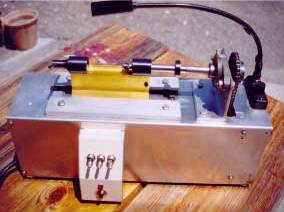 |
|
"Handmade trimmer and
prep
machine uniforms 100 primer pockets in 10 minutes." |
|
Besides trimming, Rick also uniforms his primer pockets and primer
flash holes to achieve the most uniform ignition. To do so, Rick actually
designed and built his own machine that handles all of these operations. Looking
something like an oversized shoe box with an overhead light, the machine turns
something like five different spindles - each with a different function. The
machine uses a fairly powerful electric motor so thereís plenty of torque and
speed available to get things done rapidly. In fact, Rick says he can prepare
100 cases in 10 minutes (primer pockets). Not having a magic machine, I use an RCBS power case
trimmer instead. It does a good job, but itís definitely not as fast as Rickís
machine.
|
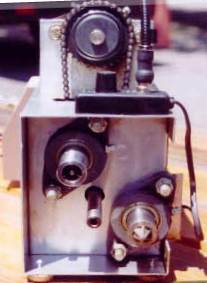 |
|
"Some of the spindles
used to prep brass." |
|
He also seats and crimps in two separate operations. He uses a normal
seating die backed out slightly so thereís no crimp. During the seating
operation, heíll start pushing the bullet into the case, then stops, backs off,
and then rotates the case 180 degrees. Heíll then seat the bullet all the way
in. If thereís any degree of misalignment between the die and the shell holder,
rotating the case will help to minimize that. This is a method I also used for a
long time until I started using a
Redding Competition Pistol Bullet Seating Die.
For exact seating of revolver bullets, this tool is a must.
Speaking of Redding, Rick also uses their profile crimp die in a
separate operation. This die is the only one that uses a combination of a taper
crimp as is normally used for semi auto ammo which headspaces on the case mouth,
and a standard roll crimp at the same time. There is no better crimp from any
other die. A good firm crimp is mandatory for consistent results especially when
using magnum ball powders.
|
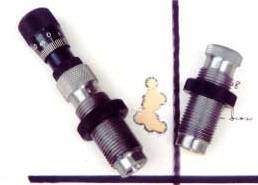 |
|
"Use of Redding
competition seating dies
and profile crimp dies can help to produce 10 shot, 50 yard groups like this one." |
|
Let me give you an example of how well the Redding profile crimp
works. While recently testing some jacketed bullet loads, I found that two of
them were too hot and so immediately stopped. One load had a standard roll crimp
and the other had the profile crimp. Once I got home, I decided to tear down the
cartridges with my RCBS inertia bullet puller. It just took 2 whacks with the
puller to knock out the 180 grain bullets from the roll crimped cases. On the
other hand, it took 1 to 2 DOZEN whacks to knock out the bullets from the
profile crimped cases. If that doesnít convince you that the profile crimp is
the stronger of the two types, I donít know what will. It certainly convinced
me.
|
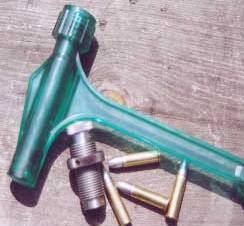 |
|
"Profile crimping is the strongest there is." |
One last point
about crimping, most reloading manualís will tell you to chamfer the inside of
the case mouth. The purpose of inside chamfering is to bevel the inside edge of
the case mouth and prevent the heel of the bullet from getting scraped up during
the seating procedure. If it does get scratched or scrapped, accuracy will
suffer. However, thatís why we use the expander die to bell the mouth of the
case. So thereís really no need to chamfer. Itís really a redundant operation
for revolver brass. Besides, when you do chamfer, youíre removing metal and
making the case wall very, very thin at the mouth. Actually, we want as much
metal as possible at that location so we can get the best grip on the bullet.
Bottom line - do as Rick does and save yourself some trouble and get better
results by skipping the chamfering.
|
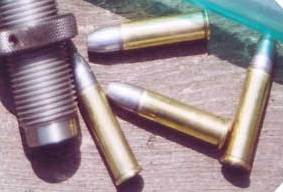 |
|
Redding Profile Crimp Die
with RCBS 200 crimped in the
cannalure |
|
Through a lot
of experimentation, Rick decided on a load of 16.2 of H110 powder, ignited by a
CCI 550 primer for his cast bullets. Indeed, this load produced very impressible
results. However, since Rick provided me with a generous supply of bullets and
his wonderfully prepared cases, I decided Iíd drive off the road a little and
try some other loads as well.
|
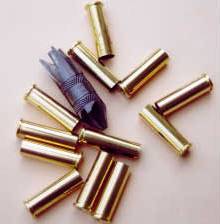 |
|
"Chamfering case mouths
is not recommended." |
|
For powders, I used mostly standard mag pistol types. They were WW296,
H110, AA #9, and Hodgdonís LilGun. I also used one powder that is not found in
the general marketplace but is sold primarily to ammo manufacturers. Itís called
H108, and is a very fine grain, some what faster burning, mag pistol powder.
Itís available from Powder Valley - a major powder and primer seller. As of this
date, an 8 pound jug of H108 is currently on special for $50. Check their web
site at (powdervalleyinc.com). Good
loads could be developed with any of these powders.
Thereís been some minor historical debate on whether rifle or regular mag pistol primers are best when developing loads for heavy cast bullets. In
this particular evaluation I didnít find any particular advantage one way or
another. I had good performing loads with both. Since the amounts of powder I
used in this case were not particularly great, I tended to use mostly mag pistol
primers, however Rick likes CCI 550ís for his pet load and indeed it did
produce high quality results.
|
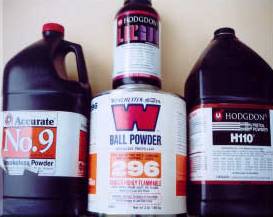
|
|
"All powders produced
great groups with the special
Kelter/RCBS bullets." |
|
In the end, itís safe to say that carefully prepared cast bullets
coupled with cases that are just as carefully massaged will produce exceptional
results in the
Freedom Arms Revolver. In fact, these cast bullets will produce
even better results than most jacketed bullet loads. Best of all, these bullets
can be produced for very little money. On the other hand, producing top quality
cast bullets takes time, so in effect you could say that youíre trading time for
money. While there are people who cast to save money, I think that most enjoy
the challenge of producing the best bullets possible all by themselves. As Rick
has told me several times, itís "a labor of love".
|
Good luck and good
shooting, Todd |
Top of Page |
| |
|
| |
|
|
Load Data and Range Test
Results Below |
|
|
![]()